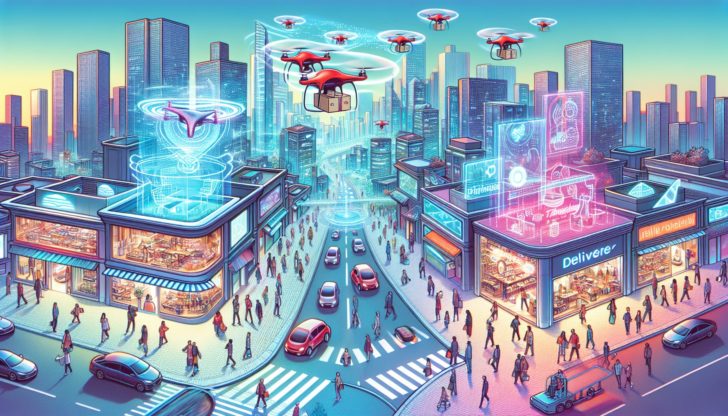How is the phygital approach reshaping retail experiences? By merging the immediacy of digital with the tangibility of physical, phygital marketing fills the gap that today’s consumers didn’t even know existed. This article goes beyond the buzz to unpack how businesses use phygital to foster deeper engagement and loyalty, providing a roadmap for those ready to weave digital innovation into the fabric of physical customer interactions.
Table of Contents
Key Takeaways
Phygital marketing integrates both physical and digital realms to enhance the customer experience by using technologies like AR and VR, while ensuring convenience and personalization in response to changes in consumer behavior.
A successful phygital strategy involves omnichannel integration, leveraging data-driven insights, and adopting innovative technologies such as AI, machine learning, and AR/VR to provide seamless and immersive customer experiences.
The effectiveness of phygital marketing can be measured through KPIs like website traffic, conversion rates, and customer engagement, and despite implementation challenges, the future holds promising opportunities with technologies like blockchain, NFTs, and the metaverse.
The Essence of Phygital

Phygital marketing – the term might sound like a futuristic concept, but it’s already reshaping the way we interact with brands. At its core, phygital is all about integrating physical and digital experiences to create a seamless customer journey. This innovative approach addresses the modern consumer’s demands for:
instant gratification
convenience
autonomy
immersive interactions
The advent of phygital marketing reflects a significant shift in consumer behavior, with a preference for interactive and personalized experiences. A successful phygital strategy taps into the power of technologies like augmented reality (AR) and virtual reality (VR), enhancing the shopping experience, and meeting consumer demands for physical engagement.
The Evolution of Phygital Marketing
The rise of smartphones in the 2000s marked a significant turning point in marketing, shifting the focus from traditional physical spaces to digital platforms. Digital marketing, powered by digital technology, gave consumers more control over the content they engaged with and paved the way for targeted, data-driven marketing strategies. Businesses have been able to utilize digital platforms for their marketing needs, resulting in:
Improved efficiency and effectiveness in promoting their products or services
Increased reach and visibility to a wider audience
Better targeting and personalization of marketing messages
Access to real-time data and analytics for measuring campaign performance
Cost-effective advertising options compared to traditional media
Digital marketing has revolutionized the way businesses connect with their customers and has become an essential component of any successful marketing strategy, including the implementation of digital solutions.
Despite the digital revolution, the physical world never lost its relevance. A whopping 63% of shopping occasions still begin online, signifying the critical role of digital channels in consumers’ purchasing journeys. This blend of physical and digital experiences laid the foundation for the emergence of phygital marketing, providing seamless and personalized physical experiences in both physical and digital worlds.
Key Components of a Successful Phygital Strategy
A successful phygital strategy is not a simple cut-and-paste job. It requires a robust omnichannel integration, data-driven insights, and the adoption of innovative technologies like artificial intelligence (AI), machine learning, and AR/VR.
Let’s delve into these components in more detail.
Omnichannel Integration
In the world of phygital, omnichannel commerce holds a significant place. It ensures a unified and consistent shopping experience, bridging online, in-store, and mobile app interactions seamlessly. It’s about providing a frictionless buying process and smooth transitions between browsing, adding items to carts, and completing purchases, all aided by the convenience of mobile payments.
Today’s consumers demand seamless and convenient shopping experiences, driven by their customer expectations. They expect to navigate effortlessly from websites to physical stores, deciding when, where, and how to shop. Therefore, ensuring a cohesive view of customer interactions through a data management platform is crucial for tailoring and optimizing the customer experience across various touchpoints. Implementing effective customer experience management can help businesses meet these expectations and deliver a consistent experience.
Data-Driven Insights
Data is the new oil, and phygital marketing is no exception. Businesses leveraging phygital interactions have access to valuable data on customer behavior and preferences across multiple channels, aiding the creation of personalized marketing campaigns.
But, it’s not just about collecting data – it’s about making sense of it. Advanced analytics tools enable:
Real-time tracking of key metrics
Construction of custom dashboards
Facilitating data-driven decision-making
Optimization of marketing ROI
Additionally, implementing revenue attribution models allows businesses to discern the contribution of different phygital marketing touchpoints to overall revenue generation.
Innovative Technology Adoption
Embracing digital technologies is a critical component of a successful phygital strategy. Some examples of these technologies include:
Voice-based AI
Chatbots
Augmented reality (AR)
Virtual reality (VR)
Wearable devices
For instance, AI can guide customers in retail settings to products that match their personal preferences, enhancing their shopping experience.
AR, on the other hand, provides interactive and immersive experiences. STM Goods’ augmented reality app, which allows customers to virtually try on backpacks at home, is a prime example of how AR is enhancing the retail shopping experience. And let’s not forget wearable technology, such as smartwatches and AR glasses, and cloud computing – they’re all playing a crucial role in shaping the phygital landscape.
Real-Life Phygital Success Stories

Success stories are always inspiring, aren’t they? Let’s look at some real-life examples of brands that have successfully implemented phygital strategies. Glossier and Reformation, for instance, have designed their showroom and retail spaces to offer immersive brand experiences and mirror online shopping conveniences, facilitating interactions and a seamless blend of physical and digital.
Companies like Sonos and B8ta have created interactive experiences in-store through sound chambers and product testing areas to engage customers and collect preference data. Nike and Warby Parker offer personalized services, such as in-store sneaker customization and a seamless ‘try on at home’ experience that merges offline and online preferences, enhancing the in person experience for their customers.
Event and entertainment sectors aren’t left behind either. Huda Beauty’s physical ‘Mercury Retrograde’ pop-up event in London led to a measurable impact on sales and an increase in their online following, demonstrating the power of phygital activations. Similarly, the use of digital tickets in sports stadiums offers fans a more interactive and convenient way to enjoy live events.
These success stories highlight the power of phygital marketing in creating memorable phygital customer experiences, increasing brand recall, and fostering customer loyalty.
Overcoming Challenges in Phygital Implementation
Implementing phygital systems is not without its challenges. Businesses may encounter a temporary drop in productivity as personnel adapt to new workflows and troubleshoot problems. During these times, developing stopgap instructions can be crucial for maintaining operational continuity.
Post-implementation testing of phygital solutions is also critical and must be conducted vigilantly to ensure they do not introduce new issues. Moreover, in a rapidly evolving digital landscape, businesses need to persistently reassess and enhance their phygital strategies to stay relevant and effective.
Future Opportunities in Phygital Marketing
As we look towards the future, several exciting opportunities are emerging in phygital marketing. One such opportunity lies in blockchain technology, which offers solutions for customer data protection, authenticating products, and improving supply chain transparency.
Then there are NFTs, or non-fungible tokens, which bridge the physical and digital realms, offering unique ownership experiences, like owning a physical piece of art while accessing exclusive digital content. And let’s not forget the metaverse, which provides a new frontier for brand integration in phygital marketing by capitalizing on its mass appeal and unique digital experiences.
Steps to Create Your Own Phygital Experience
So, ready to create your own phygital experience? Here’s a step-by-step guide to get you started.
First, research your customers’ journeys thoroughly. Understand their needs, preferences, and pain points. This research will form the foundation of your phygital strategy.
Next, set clear goals. What do you want to achieve with your phygital strategy? These goals will guide your tactics and help measure your success.
Start small when transitioning to phygital to ensure a smooth integration of new strategies. Carefully integrate campaigns to leverage the strengths of both offline and online channels, creating a consistent phygital experience.
Finally, test physical automation with real products to identify issues before full phygital implementation.
Learn more, visit How to Create Phygital Experiences.
Measuring the Impact of Phygital Marketing
Measuring the impact of your phygital marketing efforts is crucial for continuous improvement. To do this, identify key performance indicators (KPIs) that apply to both the physical and digital aspects of your campaigns.
Common phygital marketing KPIs include:
Measuring website traffic
Conversion rates
Customer acquisition costs
Engagement and awareness metrics
By tracking these KPIs, you can gauge the success of your campaign and make necessary adjustments for better performance.
Summary
Phygital marketing is more than just a buzzword; it’s a powerful strategy that blends the best of physical and digital worlds to create immersive and engaging customer experiences. From leveraging technologies like AR and AI to employing data-driven insights and robust omnichannel strategies, phygital marketing offers a myriad of opportunities for businesses to connect with their customers in meaningful ways. As we step into the future, the scope of phygital marketing is set to expand even further, offering exciting opportunities for businesses to innovate, engage, and succeed.
Frequently Asked Questions
What is phygital marketing?
Phygital marketing combines physical and digital experiences to create a seamless and immersive customer journey.
How does phygital marketing enhance customer experiences?
Phygital marketing enhances customer experiences by using AR and VR technologies to create immersive interactions and meet consumer demands for physical engagement. This helps in responding to modern demands for instant gratification, convenience, and autonomy.
What are some key components of a successful phygital strategy?
In conclusion, a successful phygital strategy includes omnichannel integration, data-driven insights, and innovative technologies such as AI, machine learning, and AR/VR. Embracing these components can significantly enhance the overall strategy.
Can you provide some examples of real-life phygital success stories?
Sure, Glossier, Reformation, Nike, and Warby Parker have successfully used phygital strategies to create immersive brand experiences that blend offline and online preferences.
What future opportunities exist in phygital marketing?
Phygital marketing presents future opportunities such as blockchain technology for data protection, NFTs for unique ownership experiences, and the metaverse for brand integration. Embracing these innovations can help businesses stay ahead in the evolving marketing landscape.









